![]()
![]()
![]()
Use LEFT and RIGHT arrow keys to navigate between flashcards;
Use UP and DOWN arrow keys to flip the card;
H to show hint;
A reads text to speech;
110 Cards in this Set
- Front
- Back
|
NAS stands for |
Network attached storage |
|
|
How does NAS attach to a network |
Via a USB cable |
|
|
Disk geometry is |
The physical components of a drive that make up your data storage device. |
|
|
A platter is |
a physical object (plate) inside the hard disk that is responsible for storing the data, spins on a spindle that runs in the middle of the platter. |
|
|
Physical form of data stored on hard drive platters |
In tracks like a record |
|
|
Unique ID system for each platter |
Each platter has 2 sides, the first platter has side 0 and 1, the second has side 2 and 3 and so on |
|
|
A platter side aka |
head |
|
|
head aka |
read/write head |
|
|
How does the head move |
via the activator arm |
|
|
activator arm aka |
head positioning mechanism |
|
|
A sector is |
a pie-shaped area on the platter |
|
|
A sector block is |
A block created when a track intersects with a sector |
|
|
sector block aka |
sector |
|
|
Size of a sector block |
512 bytes |
|
|
what is the sector block address made of |
platter side number sector number track number |
|
|
A cluster is |
a group of sectors |
|
|
The allocation unit for a file |
a cluster |
|
|
a partition is |
a logical division of space on the disk |
|
|
How are the tracks on a platter numbered |
from the outside in |
|
|
a cylindar is |
the same track on both sides of all of the platters |
|
|
formula to calculate the size of a disk |
cylinders x # of heads x # of sectors/track x 512 |
|
|
How does the read/write process works |
Write: The head moves until it reaches the desired track then for the desired sector. Head is energized to apply magnetic charge to particles in magnetic disk coating. Read: same but no data applied only read |
|
|
How far above the surface of the disk is the head |
10 micro-inches |
|
|
Why doesn't the head touch the surface of the platter? |
No friction created, no loss of platter spin speed |
|
|
Measurements of magnetic disk performance |
seek time latency access time spin speed |
|
|
seek time is |
how long it takes to move the heads to the desired track |
|
|
seek time is measured in |
milliseconds |
|
|
latency in disk performance is |
how long it takes for the appropriate sector to move under the head |
|
|
access time is |
the overall speed of the disk, combination of seek time and latency |
|
|
spin speed is |
how fast the platter spin |
|
|
spin speed is measured in |
rotations per minute |
|
|
MBR stands for |
master boot record |
|
|
MBR is |
the first sector on the first track of the first side of the first platter |
|
|
What does the MBR hold |
the operating system boot code that controls the loading of the OS and the partition table |
|
|
LBA stands for |
logical block addressing |
|
|
ECHS stands for |
extended cylinder/head/sector |
|
|
what do LBA and ECHS do |
sector translation |
|
|
what is sector translation |
the hard drive controller lying to the BIOS about the drive geometry. |
|
|
who developed LBA |
Western digital |
|
|
who developed ECHS |
Seagate |
|
|
LBA recognizes _____cylinders, _____ heads and _______ sectors, total size ______ |
1024 256 63 8.4GB |
|
|
What is the translation factor used for |
LBA uses it to conform the hard drive cylinders and heads to the LBA limits. If the hard drive has too many cylinders the number is divided. If the heads are too few the number is multiplied |
|
|
The hard drive controller is responsible for |
converting signals made by the system CPU to signals that the hard disk can understand |
|
|
What kind of information does the hard drive controller handle |
instructions on where to find data and how to get to that data |
|
|
What happens once the data is found by the hard drive |
It sends the data to the hard drive controller to covert into signals the system can understand |
|
|
What was the goal of developing IDE |
Make installation of hard disks easier by including the hard disk controller on the hard disk |
|
|
IDE stands for |
integrated drive electronics |
|
|
# of devices IDE can support in a chain |
2 |
|
|
IDE hard drive max size |
528MB |
|
|
IDE transfer rate |
10 MBps |
|
|
What replaced IDE |
EIDE |
|
|
EIDE stands for |
Enhanced integrated drive electronics |
|
|
EIDE transfer rate |
16 MBps |
|
|
# of devices EIDE can chain |
4 |
|
|
EIDE max capacity |
200GB |
|
|
Types of devices for IDE |
hard drive only |
|
|
Types of devices for EIDE |
hard drives, cd roms, zip drives |
|
|
How does the IDE attach to the motherboard |
40 wire ribbon cable |
|
|
IDE aka |
ATA standard |
|
|
ATA stands for |
Advanced technology attachment |
|
|
ATA aka |
ATA-1 |
|
|
EIDE standard allows _____ drives to be connected to a _______ ________ _______ |
4 dual channel controller |
|
|
ATAPI stands for |
ATA packet interface |
|
|
what does the ATAPI do |
allows other types of devices to exist on an ATA chain |
|
|
ATAPI devices |
cd roms, tape drives, cd writers, dvd devices, zip drives |
|
|
2 major benefits of Ultra DMA over ATA |
speed reliability |
|
|
Speed of Ultra DMA |
33.3 or 66.6 MBps |
|
|
How does Ultra DMA add reliability |
implements error correction for increased data reliability |
|
|
Describe the Ultra DMA/66 cable |
80 wire cable with 40 wire IDE type cable combined with 40 wires of ground for reduced noise and increased performance |
|
|
PIO stands for |
programmed I/O |
|
|
PIO mode |
protocol tat determines the transfer rate of the drive |
|
|
PIO mode aka |
DMA mode |
|
|
DMA 33 transfer rate |
33.3 MBps |
|
|
DMA 66 transfer rate |
66.6 MBps |
|
|
DMA 100 transfer rate |
100 MBps |
|
|
DMA 133 transfer rate |
133 MBps |
|
|
Floppy drive ribbon |
34 wire |
|
|
Purpose of designating a master |
To specify which controller is responbile for communicating with the processor |
|
|
What do you configure to set master/slave disk drives |
jumpers |
|
|
Where are SCSI drives found |
high end machines such as powerful workstations or servers |
|
|
SCSI stands for |
Small computer system interface |
|
|
SCSI "brain" |
SCSI adapter |
|
|
SCSI adapter aka |
SCSI card or controller |
|
|
SCSI adapter responsible for |
managing all SCSI devices and controlling the conversation on the SCSI chain |
|
|
3 advantages of SCSI over IDE |
types of devices supported # of devices supported in single chain performance of SCSI over IDE devices |
|
|
Types of devices supported by SCSI drives |
hard drives cd roms scanners printers tape drives |
|
|
How many devices are supported by SCSI |
8 |
|
|
How many devices can be attached to SCSI |
7 |
|
|
What is the SCSI host adapter |
An expansion card that you add to the computer so you can chain SCSI devices off the adapter |
|
|
What does the SCSI host act as |
Controller for the SCSI bus |
|
|
SCSI controller is responsible for |
sending and receiving all information to and from the SCSI bus |
|
|
SCSI ID is |
an internal address assigned to each device on the SCSI adapter card |
|
|
How do you assign the SCSI ID to each device |
Either by jumpers or by DIP switches if internal or by a spinner if device is external |
|
|
What is a spinner |
An indicator on the back of the external SCSI device whose value you can change by pressing the button to increase or decrease the SCSI ID |
|
|
Numbers assigned to SCSI jumpers from left to right |
4 2 1 |
|
|
Jumper set up for SCSI ID 0 |
no jumper on any pin |
|
|
Jumper set up for SCSI ID 3 |
no jumper on 4, jumper on 2 and 1 |
|
|
Jumper set up for SCSI ID 6 |
jumper on 4 and 2, no jumper on 1 |
|
|
"automatic" SCSI IDs that should be assigned |
Host adapter = 7 bootable hard drive = 0 |
|
|
Why is the bootable hard drive given an ID of 0 |
the controller automatically looks for the SCSI ID of 0 in order to boot off a SCSI hard drive |
|
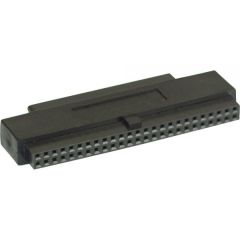
|
50 pin IDC female |
|
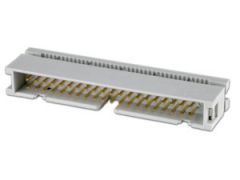
|
50 pin IDC male |
|
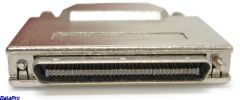
|
68 pin high density male |
|
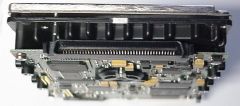
|
80 pin SCSI SCA connector |
|
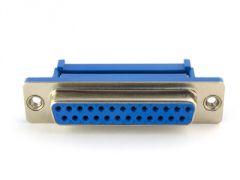
|
DB 25 female |
|
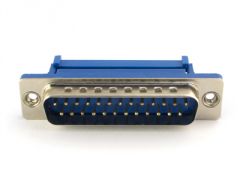
|
DB 25 male |
|
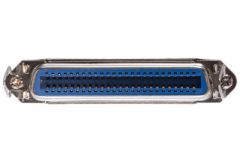
|
50 pin centronics |
|

|
50 pin high density |
|

|
68 pin high density |
|
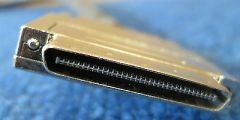
|
68 pin very high density |

